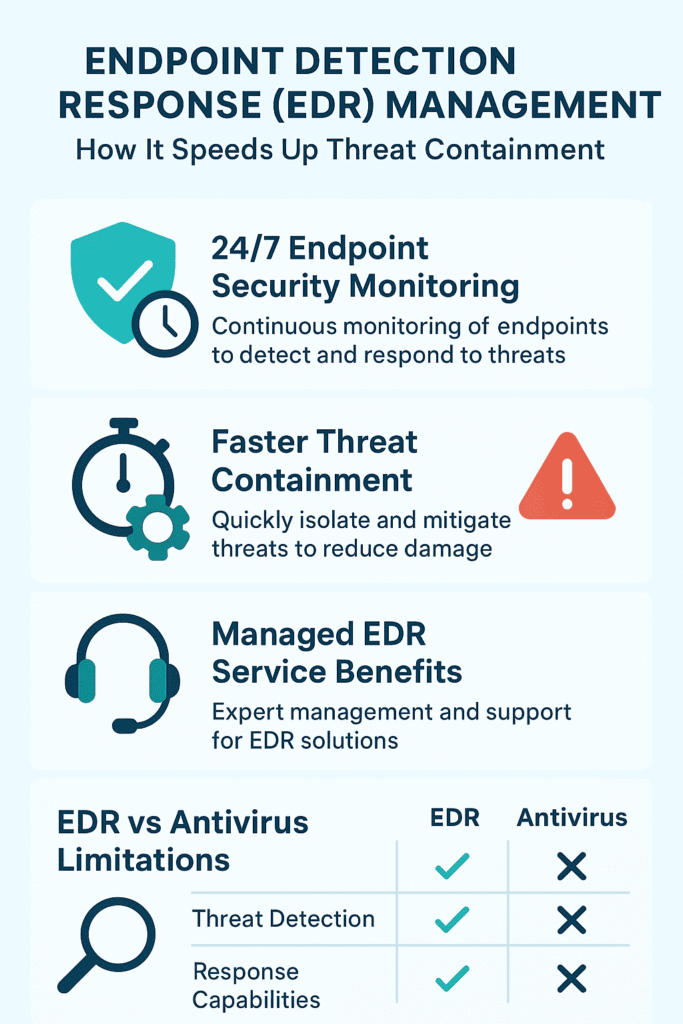Address
304 North Cardinal St.
Dorchester Center, MA 02124
Work Hours
Monday to Friday: 7AM - 7PM
Weekend: 10AM - 5PM
Address
304 North Cardinal St.
Dorchester Center, MA 02124
Work Hours
Monday to Friday: 7AM - 7PM
Weekend: 10AM - 5PM

Endpoint Detection and Response (EDR) management is designed to stop modern threats at the device level, before they spiral into full-blown breaches. With laptops, tablets, and phones multiplying across every organization, each endpoint becomes a potential entry point attackers can exploit.
EDR continuously monitors these devices, detecting suspicious behavior and shutting it down in real time. Unlike traditional antivirus, it doesn’t just record what happens; it actively responds to contain threats as they unfold. For security teams, that means faster action, fewer blind spots, and stronger defenses.
Keep reading to learn how EDR management accelerates threat containment.

When you’re dealing with endpoint threat detection these days, it’s not just about running scans or catching viruses. Picture hundreds of laptops, servers, and mobile devices, each one sending back streams of data 24/7. System processes, network connections, user activity logs , it’s all there, waiting to tell a story.
These systems don’t just alert, they act. EDR (Endpoint Detection and Response) solutions automatically quarantine devices, kill suspicious processes, and block access as needed. They also alert security teams instantly, minimizing response times and operational impact (1)
The cool part? It doesn’t just sit there waiting for someone to notice. The system jumps into action , quarantines the device, kills suspicious programs, locks down access. All while shooting alerts to the security team’s phones.
Let’s be real , running EDR isn’t exactly a walk in the park. You need people watching screens round the clock, threat hunters who know their stuff, and someone tweaking those detection rules constantly. That’s why managed services make sense.
These providers basically become your security team, offering more than just tools, they bring in structured core service offerings like endpoint monitoring, log analysis, and rapid response. Your IT folks can focus on keeping the lights on while the specialists handle the heavy lifting.
The service usually comes with some solid perks , active threat hunting (because some nasty stuff likes to hide), detailed investigations when something does slip through, and automated responses that don’t wait for human approval.
The math’s pretty simple on this one. You get a whole team of experts watching your back 24/7, and it costs less than hiring even one good security analyst (trust me, they don’t come cheap). Plus, these teams have access to tools and threat feeds that’d blow most IT budgets.
They’re also great at keeping the paperwork straight , compliance reports, incident documentation, all that fun stuff that auditors love to see. Most companies we’ve worked with see attacks drop off pretty quick once they switch to managed EDR.
Paperwork and compliance? Covered. Managed EDR providers deliver built-in compliance support and audit-ready documentation, a life-saver during reviews and regulatory inspections (2)
At its core, EDR’s about the platform doing the heavy lifting. It’s collecting data from every endpoint, running it through advanced analytics, and spotting things that just don’t look right. The best part? It catches those zero,day threats that regular antivirus software doesn’t even know exist yet.
When something sketchy shows up, the platform’s got a whole toolkit ready, isolate the machine, cut off network access, whatever it takes to stop the spread. Then the analysts dig in, connecting the dots between different logs and figuring out exactly what happened.
Most antivirus programs are stuck in the past, relying on a database of known malware signatures. They’re like old security guards checking ID cards against a list of known troublemakers. When new threats show up or criminals get creative with fileless attacks, these programs just stand there scratching their heads.
EDR steps in where antivirus falls short, watching everything happening on endpoints (computers, phones, servers) 24/7. It’s not just looking for known bad guys , it’s studying behavior patterns and catching anything suspicious. Think of it as having a smart security camera system instead of just a bouncer with a checklist.

Credit: pexels.com (Photo by ThisIsEngineering)
Finding the right EDR vendor isn’t rocket science, but it needs careful thought. Local vendors who know state laws and industry rules usually work better than distant providers who don’t understand regional requirements.
It’s also smart to look at the service level agreement they provide, since this sets clear expectations around response times and ongoing support.
A good vendor should offer:
Make sure to ask about how they’ll keep endpoint agents updated , you don’t want software that gets outdated within months.
Night brings no peace to the digital world. Cyber criminals, hunched over keyboards in dimly lit rooms, don’t clock out when the sun sets. A constant watch stands as the only real defense. Here’s what round-the-clock monitoring actually does:
Think of it like a night watchman who never dozes off, never takes breaks, never misses a thing. These days, with cyber attacks hitting every 39 seconds on average, businesses can’t afford gaps in their defense. Their data’s too valuable, their customers’ trust too precious to risk.
The threats keep changing, new malware, smarter attacks, bigger targets. But that’s exactly why 24/7 monitoring makes sense. While the rest of the world sleeps, these security teams keep their guard up, watching for anything suspicious.
Digital threats doesn’t sleep, and neither can security. Twenty,four,seven monitoring isn’t just some fancy upgrade , it’s as basic as locking the front door. In a world where a single breach costs companies an average of $4.35 million, constant vigilance isn’t optional anymore. It’s just how things have to be.
When an incident occurs, organizations need clarity as quickly as possible. An EDR investigation works like a timeline builder, reconstructing what happened on each device. Logs reveal when unusual processes started, file changes show what was tampered with, and network data highlights connections to suspicious domains. By pulling these pieces together, investigators can determine whether the activity was a harmless glitch or a coordinated attack.
This real-time perspective is a major improvement over traditional forensics that arrive after the damage is done. Just as important, the process doesn’t end once the breach is contained. Each investigation uncovers weak spots in configuration or user behavior that can be tightened for the future. The result is a cycle where every incident makes the system more resilient, turning reactive investigations into proactive defense.
Stopping endpoint threats requires speed, and EDR provides that through a structured series of actions:
This combination of automation and visibility cuts response times dramatically. What once took days of manual effort can now be reduced to hours or even minutes, limiting impact and protecting business continuity.
Rolling out an EDR platform is less about installing software and more about weaving it into the daily operations of a business. Successful deployment begins with mapping the organization’s assets and risks, ensuring the solution covers what matters most. Integration with SIEMs, ticketing systems, or identity management tools often follows, so alerts flow smoothly into established workflows.
Testing is then conducted, not just to prove the tool works, but to validate whether detection rules align with the real-world environment. Training sessions round out the process, equipping IT and security staff with the skills to interpret data and take effective action.
If deployment is rushed or handled superficially, teams may be overwhelmed by noise or blind to critical activity. Managed properly, however, EDR deployment provides not only a new layer of defense but also confidence that the system is operating at its full potential from day one.
Good endpoint security doesn’t happen by accident. It takes the right tools, constant monitoring, and quick reactions when things go wrong. Working with local providers who understand your needs can make a big difference in keeping your systems safe.
Don’t wait for a breach to think about better security. Find a managed EDR service that fits your organization’s needs and budget. The sooner you act, the better protected you’ll be.
We offer expert consulting tailored for MSSPs to help streamline operations, reduce tool sprawl, and boost service quality. From vendor neutral product selection and auditing to stack optimization and decision support resources, we guide you in choosing the right tools, improving integration, and enhancing visibility.
With over 15 years of experience and 48K+ projects completed, our services include needs analysis, vendor shortlisting, PoC support, and clear, actionable recommendations, so you can build a tech stack that aligns with your business goals and operational maturity.
MSSPs deliver continuous monitoring, threat detection, and incident response as core services. They also provide managed EDR solutions, vulnerability management, and compliance support. By outsourcing to MSSPs, organizations gain 24/7 security operations expertise, reducing risk while scaling protection without heavy investment in internal resources.
Endpoint detection and endpoint response form the backbone of EDR management by giving teams visibility into devices. With endpoint security tools, they track suspicious activity, flag anomalies, and support threat detection.
This approach supports threat hunting, incident investigation, and malware detection while also helping with ransomware defense. EDR management provides endpoint isolation and continuous monitoring to limit damage.
Endpoint protection relies on security analytics to analyze endpoint telemetry and endpoint logging. By combining threat intelligence with AI threat detection and machine learning security, teams strengthen cyber threat mitigation.
EDR management applies forensic analysis, endpoint telemetry, and endpoint anomaly detection to guide teams. This ensures endpoint event correlation, endpoint visibility, and effective security alert management in security operations center workflows.